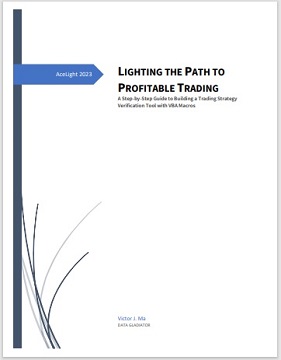Stock Market Chart Strategies: A Brief Guide for Successful Trading
|
|
If you are a beginner or an experienced trader looking to enhance your
trading skills, understanding and effectively utilizing stock market charts
can significantly improve your trading outcomes. In this article, we will
explore various chart patterns, technical indicators, and strategies that
can help you make informed investment decisions and maximize your profits.
1. Importance of Stock Market Charts
Stock market charts provide
a visual representation of the price movement of a particular stock, index,
or market over time. They are crucial tools for traders as they allow for
analysis, identification of trends, and prediction of future price
movements. By analyzing stock market charts, traders can identify potential
buying and selling opportunities, assess risk levels, and develop effective
trading strategies.
2. Types of Stock Market Charts
a. Line
Charts: Line charts are the simplest type of stock market charts,
representing the closing prices of a stock over a given period. They provide
a basic overview of price trends and are useful for identifying long-term
patterns.
b. Bar Charts: Bar charts display the high, low, open, and
closing prices of a stock for a specific time period. Each bar represents a
single trading session, making it easier to analyze price movements and
patterns within a shorter timeframe.
c. Candlestick Charts:
Candlestick charts are widely used due to their ability to convey more
detailed information than other chart types. They provide insights into the
market sentiment and allow traders to identify potential reversals, support
and resistance levels, and patterns such as doji, hammer, and engulfing
patterns.
3. Chart Patterns
a. Trend Patterns: Trend patterns
help traders identify the direction in which a stock is moving. Some common
trend patterns include uptrends, downtrends, and sideways trends. By
recognizing trend patterns, traders can enter positions that align with the
prevailing market sentiment.
b. Reversal Patterns: Reversal patterns
signal potential changes in the trend direction. Examples of reversal
patterns include head and shoulders, double tops, and double bottoms. These
patterns indicate that a stock's price may reverse its current trend,
providing traders with opportunities to profit from such reversals.
c. Continuation Patterns: Continuation patterns suggest that the prevailing
trend is likely to continue after a temporary pause. Examples of
continuation patterns include flags, pennants, and triangles. By identifying
continuation patterns, traders can stay in trades that are likely to yield
further profits.
4. Technical Indicators
a. Moving Averages:
Moving averages are widely used technical indicators that help smooth out
price fluctuations and identify the overall trend. Traders commonly use the
50-day and 200-day moving averages to assess the stock's direction and
potential support and resistance levels.
b. Relative Strength Index
(RSI): The RSI is a momentum oscillator that measures the speed and change
of price movements. It ranges from 0 to 100 and helps traders identify
overbought or oversold conditions, potential trend reversals, and divergence
between the price and the indicator.
c. Bollinger Bands: Bollinger
Bands consist of a middle band (usually a moving average), an upper band,
and a lower band. These bands help traders identify volatility, potential
trend reversals, and periods of consolidation. When the price moves near the
upper band, it may indicate overbought conditions, while prices near the
lower band may suggest oversold conditions.
5. Trading Strategies
a. Breakout Strategy: This strategy involves identifying chart patterns
such as triangles, rectangles, or channels, and entering trades when the
price breaks out of these patterns. Traders aim to capture the momentum that
often follows a breakout, potentially yielding substantial profits.
b. Pullback Strategy: The pull back strategy focuses on entering trades
during temporary price retracements within an established trend. Traders
wait for a stock's price to pull back to a support level or a moving average
before entering a trade in the direction of the overall trend. This strategy
allows traders to enter positions at more favorable prices with reduced
risk.
c. Moving Average Crossover Strategy: This strategy involves
using two or more moving averages of different time periods, such as a
50-day and a 200-day moving average. When the shorter-term moving average
crosses above the longer-term moving average, it signals a potential uptrend
and provides a buy signal. Conversely, when the shorter-term moving average
crosses below the longer-term moving average, it indicates a potential
downtrend and triggers a sell signal.
d. Range Trading Strategy:
Range trading involves identifying stocks that are trading within a specific
price range. Traders look for support and resistance levels and enter buy
orders near the support level and sell orders near the resistance level.
This strategy aims to capture profits from price oscillations within the
established range.
e. Fibonacci Retracement Strategy: Fibonacci
retracement levels are based on the Fibonacci sequence and are used to
identify potential support and resistance levels. Traders use these levels
to determine entry and exit points. For example, a trader might enter a long
position when a stock's price retraces to a Fibonacci support level,
anticipating a bounce back up.
6. Risk Management and Trade Execution
While chart patterns and technical indicators are valuable tools, it's
essential to incorporate proper risk management techniques and execute
trades effectively. Here are some important considerations:
a.
Position Sizing: Determine the appropriate position size based on your risk
tolerance and the specific trade's potential risk and reward. Never risk
more than you can afford to lose.
b. Stop Loss Orders: Set stop loss
orders to limit potential losses if the trade goes against you. Stop loss
levels should be placed based on technical analysis, support and resistance
levels, or percentage-based risk tolerances.
c. Take Profit Levels:
Identify your profit targets based on resistance levels, previous highs, or
a predetermined risk-to-reward ratio. Taking profits ensures you capture
gains and avoid holding onto positions for too long.
d. Trade
Execution: Use limit orders to enter trades at specific price levels rather
than relying solely on market orders. This allows you to enter trades at
desired prices and avoid unfavorable slippage.
e. Continuous Learning
and Adaptation: The stock market is dynamic, and strategies that work in one
market condition may not be as effective in another. Stay updated on market
trends, news, and changes in market dynamics. Continuously evaluate and
adapt your strategies as needed.
 f.
Back-Testing and Forward-Testing: Testing is a necessary step in the
development and implementation of any successful trading strategy,
regardless of its complexity. By using these testing methods, traders can
gain valuable insights into the performance of their strategies and make
adjustments as needed to optimize their results. So, if you want to succeed
in the stock market, make sure to prioritize testing before putting your
capital at risk. For more information, Click
LIGHTING THE PATH TO PROFITABLE TRADING: A Step-by-Step Guide to Building a Trading Strategy Verification Tool with VBA Macros to get the whole tutorial handbook for free! f.
Back-Testing and Forward-Testing: Testing is a necessary step in the
development and implementation of any successful trading strategy,
regardless of its complexity. By using these testing methods, traders can
gain valuable insights into the performance of their strategies and make
adjustments as needed to optimize their results. So, if you want to succeed
in the stock market, make sure to prioritize testing before putting your
capital at risk. For more information, Click
LIGHTING THE PATH TO PROFITABLE TRADING: A Step-by-Step Guide to Building a Trading Strategy Verification Tool with VBA Macros to get the whole tutorial handbook for free!
And click Free Trial to download strategies testing tools, all for a 30-day Free Trial.
Click on Subscription to order more strategies testing tools to help your stock trading.
As we wrap up our whirlwind tour of stock market chart strategies,
it's time to end on a light-hearted note. Remember, trading is a serious
business, but that doesn't mean we can't find humor in its quirks and
complexities. So, let's bid farewell to the market circus with a chuckle or
two. And just like that daring tightrope walker who occasionally slips but
manages to regain their balance, we must embrace the occasional missteps in
our trading journey. In the midst of all the ups and downs, let's not forget
to take a step back and appreciate the absurdity of it all. The stock market
can be as unpredictable as a clown juggling flaming torches while riding a
unicycle. So, buckle up, because in this thrilling market ride, we never
know what surprises await us around the corner. Trading may test our
patience and resilience, but it also presents us with opportunities for
growth, learning, and yes, a few laughs along the way. So, whether you find
yourself celebrating gains or scratching your head over losses, remember to
approach it all with a smile and a sense of humor. May your trading journey
be filled with profitable trades, unexpected joyrides, and plenty of laughs.
Happy trading, and may the market always keep you entertained!
|


|

Free Tutorial
Share
|
|
|
|